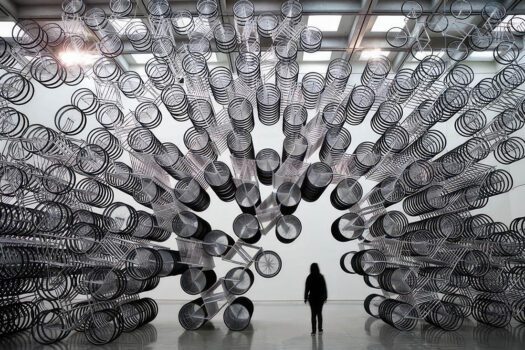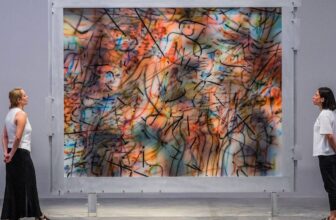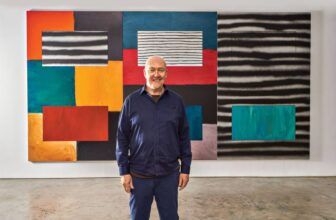Contemporary Artist From the Sleeping Giant
In the shimmering haze of Beijing’s shifting skyline, where ancient history wrestles with the thunder of modern construction, one voice rises persistently against conformity. It is not a shout, nor a whisper, but a bold visual and conceptual statement that has echoed across continents. That voice belongs to Ai Weiwei, a Chinese contemporary artist, architect, activist, and iconoclast whose art has challenged not only aesthetic boundaries but political ones as well.
To understand Ai Weiwei is not merely to understand a man who makes sculptures or installations. It is to encounter a philosophy, a rebellion, a chronicle of defiance told through porcelain shards, steel rods, Lego bricks, and digital code. Ai Weiwei is not just making art , he’s making a statement.
Ai Weiwei rose to global prominence not just as an artist, but as an outspoken critic of authoritarianism and censorship. His work transcends traditional art forms to become political critique and cultural commentary. Perhaps most notably, Ai investigated the Chinese government’s mishandling of the 2008 Sichuan earthquake , which killed nearly 70,000 people , including thousands of children who died in poorly constructed school buildings.
He created the installation “Remembering” (2009), made from 9,000 school backpacks arranged on the façade of Munich’s Haus der Kunst. The backpacks spelled out a quote from a grieving mother: “She lived happily for seven years in this world.” This was not just an artwork; it was an act of public mourning and protest.
Ai Weiwei has also taken strong stances on freedom of expression, human rights, and refugee issues. His installations, documentaries, and social media presence have all served as tools to critique oppressive regimes and amplify silenced voices. His arrest in 2011 by Chinese authorities , where he was detained for 81 days without formal charges , catapulted him from an art-world icon into a global symbol of resistance.
How Famous Is Ai Weiwei?
Ai Weiwei is one of the most famous living artists in the world today. He is as much a cultural figure as he is a creator. His fame spans both the art world and broader global audiences who may have never set foot in a gallery.
He has been the subject of multiple international retrospectives, including major exhibitions at:
The Tate Modern (London)
The Hirshhorn Museum (Washington D.C.)
The Royal Academy of Arts (London)
The Museum of Modern Art (New York)
The National Gallery of Victoria (Australia)
Ai is frequently interviewed by global media, featured in documentaries (like “Ai Weiwei: Never Sorry”), and has an enormous social media following despite being banned on Chinese platforms. His blend of activism and artistry appeals not only to curators and critics but to activists, students, and human rights defenders around the world.
How Much Does Ai Weiwei’s Art Cost?
Owning an Ai Weiwei original is not merely buying art , it’s acquiring a piece of contemporary history. His artworks command high prices at auction, often ranging from hundreds of thousands to several million dollars.
Some notable examples include:
“Circle of Animals/Zodiac Heads” (2010) , These bronze sculptures sold at auction for over $4.4 million.
“Map of China” (2004) , Made of salvaged wood from Qing Dynasty temples, this piece sold for $2.3 million.
“He Xie” (2010) , A porcelain installation symbolizing suppression, often priced at $200,000 to $400,000, depending on scale and context.
His work appeals to museums, collectors, and cultural institutions not just for its aesthetic appeal, but for its intellectual and political gravitas. Ai’s pieces are more than décor , they are dialogue.
How Does Ai Weiwei Make His Artwork?
Ai Weiwei’s process is both conceptual and collaborative. He often begins with a deeply personal or political question , a societal injustice, an untold story, or a systemic problem. From there, he uses symbolism, historical materials, and architectural forms to bring his ideas to life.
Ai rarely works alone. He employs teams of artisans, carpenters, ceramicists, and digital technologists. His studio operates more like a creative laboratory than a traditional artist’s studio. For example:
When creating his “Sunflower Seeds” (2010) installation at Tate Modern, Ai commissioned 1,600 artisans in Jingdezhen to handcraft 100 million porcelain seeds, drawing on centuries of Chinese porcelain history.
In his “Straight” (2008–12) installation, he used 150 tons of steel rebar salvaged from the collapsed Sichuan schools, which were manually straightened by workers to form a minimalist yet heartbreaking topography.
Technology also plays a significant role in Ai’s work. He has embraced 3D printing, drones, blockchain, and social media as mediums. His ability to merge traditional craftsmanship with modern techniques makes his work both timeless and timely.
How Many Artworks Does Ai Weiwei Have?
Ai Weiwei’s artistic output is extensive and diverse, spanning over 40 years and ranging across media and geography. While an exact count of his works is difficult due to the breadth of his practice , which includes sculpture, photography, installation, video, architecture, and performance , art historians and curators estimate that Ai has produced hundreds of significant works, with dozens of large-scale installations.
Some of his most iconic works include:
“Sunflower Seeds” (2010)
“Dropping a Han Dynasty Urn” (1995)
“Straight” (2008–2012)
“Remembering” (2009)
“Law of the Journey” (2017) – a 230-foot-long inflatable boat filled with refugee figures
“Good Fences Make Good Neighbors” (2017) – a citywide New York installation reflecting on immigration and nationalism
Additionally, Ai has completed architectural projects, like collaborating with Herzog & de Meuron on the Beijing National Stadium (“Bird’s Nest”) for the 2008 Olympics , a collaboration he later disavowed due to political disillusionment.
What Art Style Is Ai Weiwei Associated With?
Ai Weiwei is often associated with Conceptual Art, Contemporary Art, and Social Practice Art, though he resists being categorized. His work draws from:
Dadaism – embracing absurdity and questioning traditional aesthetics.
Minimalism – often using spare, industrial forms.
Chinese antiquity – referencing dynastic art forms, calligraphy, and symbolism.
Pop Art – employing mass-produced materials like Lego or Coca-Cola branding to convey meaning.
At the heart of Ai’s practice is a fusion of the ancient and the modern, the East and the West, the symbolic and the literal. His style is less about form and more about intent , a blend of political critique, personal narrative, and cultural interrogation.
What Materials Does Ai Weiwei Use?
Ai Weiwei is known for his use of diverse, symbolic, and often provocative materials. He selects materials not for their luxury or aesthetics, but for their conceptual resonance.
Common materials include:
Porcelain – referencing China’s historical export and craftsmanship.
Wood – often reclaimed from ancient temples, linking past to present.
Steel Rebar – salvaged from earthquake rubble, symbolizing broken trust and collective trauma.
Lego Bricks – used in portraits of political prisoners or whistleblowers; in 2015, Lego initially refused to sell him bricks for political reasons, a decision they later reversed after public backlash.
Marble – turned into sculptures of mundane items like surveillance cameras or handcuffs, highlighting state control.
Plastic and Rubber – such as in refugee-themed installations, evoking impermanence and fragility.
Digital Media – including video, VR, and data visualizations, used in activism-focused projects.
In many ways, Ai Weiwei lets the material speak. A brick is not just a brick; it is a symbol of shelter, structure, or surveillance depending on its context.
A Story Beyond the Studio
To truly appreciate Ai Weiwei’s art, one must understand the risks he has taken. Art for him is not a luxury; it is survival. It is a lifeline to truth in a world that often seeks to obscure it.
Born in 1957, Ai is the son of Ai Qing, one of China’s most revered poets, who was denounced during the Anti-Rightist Movement and sent to forced labor in the countryside. Ai Weiwei grew up in exile, surrounded by books, dirt floors, and political repression. This early experience shaped his unflinching commitment to justice and memory.
When he lived in New York in the 1980s, Ai was influenced by artists like Marcel Duchamp, Andy Warhol, and Allen Ginsberg. These influences can still be felt in his blending of political resistance with artistic expression.
Today, he lives in exile, having left China amid escalating censorship. He continues to create across the globe , from Berlin to Lisbon to the Greek refugee camps , driven by the belief that art must hold power accountable.
Ai Weiwei’s influence will not be measured in gallery labels or auction prices alone. It will be measured in the conversations he sparked, the injustices he exposed, and the courage he showed in a world where truth is often buried under bureaucracy and fear.
Whether crafting an urn, building a sculpture from 38 tons of tea, or tweeting about detained activists, Ai Weiwei is always making art with purpose. His work asks: What does it mean to be free? Who gets to speak? Who gets erased?
And perhaps most importantly: What is the role of art in the fight for truth?
Ai Weiwei doesn’t just answer that question. He embodies it. image/wikiart.org




